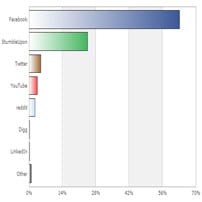In Social Media Marketing, Content in the Right Context is King
We’ve written about this topic several times before and decided to revisit it again as Social Media Marketing strategies are constantly getting refined and reiterated; and context is continuously vying for parity with content.
The above 18 minute video, Brian Solis’ June 2012 interview with Deanna Brown, CEO of Federated Media Publishing, is worth watching. According to Deanna, “Content, in the right context, is ultimately king.” If you dig into the video, pay close attention to the details. There’s some valuable but subtle information in it.
4thWeb officially replaced “content is king” with “content in the right context is king” almost four years ago. The evolution of Social Media was the driver of that change. Today, Social Media is mainstream, and “content in the right context is king” is a widely-adopted Social Media methodology mantra.
The more the context and content matches the users interests (this usually requires a longer tail), the more the content resonates with users (if it’s good of course) and drives better engagement, in dialog, sharing, and active participation. This is almost always the case no matter where the destination is; be it Facebook, a Brand site, a Blog, etc. And also within a specific sub-set of that context (e.g., a specific Facebook campaign page, Blog post, etc.).
Here’s an excerpt from our 5-part series (“The 5 Stages of Social Media Engagement”) that we wrote at the beginning of 2012. In Social Media time, an eternity.
“Full results are finally coming in. The company is completely engaged with customers. At this point, results are considered a major business breakthrough and customer satisfaction is at an all time high. Revenue increases as does customer loyalty. Customers remark that their needs are anticipated and their ideas are being used to create a better company. The company is totally immersed in social media and can’t imagine business before it. Part of the company’s main policy is social media engagement with customers. They promote themselves as a company that listens and considers customer concerns a top priority. With constant engagement, companies are able to prove that they not only listen but act on everything a customer has to say. All levels of the business are engaging customers, including top level executives. Employees are fully trained and able to anticipate customer needs. By judging customer responses to pre-promotion, companies are better able to manage financial risks, despite the difficult economic times. Companies have not only prices and profits, but live customer feedback to measure results. This allows them to constantly tailor business practices for optimal results. Social media becomes an integral part of day to day business tasks. From researching customer buzz to providing real time customer support, businesses see customers as people and employees, instead of just a way to make a profit. Engagement is tied closely to revenue with practices and services changing to meet social media needs. Both the company and its customers are happier with their new relationship. Employees are more productive and campaigns are more efficient since there is no guess work on what customers want and need.”
The above excerpt is a snapshot of a fully engaged Social Media enterprise. They’ve invested much time and treasure in Social Media and a “content in the right context is king” strategy. Not all enterprises and organizations are at this level but all should adopt “content in the right context is king” thinking. Users like and want to engage but on their own terms. They like searching, voting, playing, filtering, personalizing, creating, sharing, conversing, trying and buying; but in a context that they’re interested in, and in a way that’s comfortable and rewarding to them. And the organizations and enterprises that provide context and content (in that order) that matches users interests, and present it well, typically have high user engagement and earned media rates; the holy grail of social media.
Do you like our article “In Social Media Marketing, Content in the Right Context Is King”? If so, become a part of it … share your comments below.

![]()












